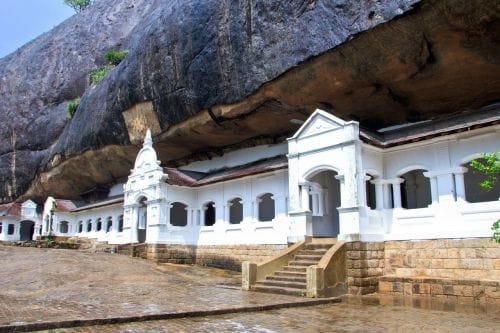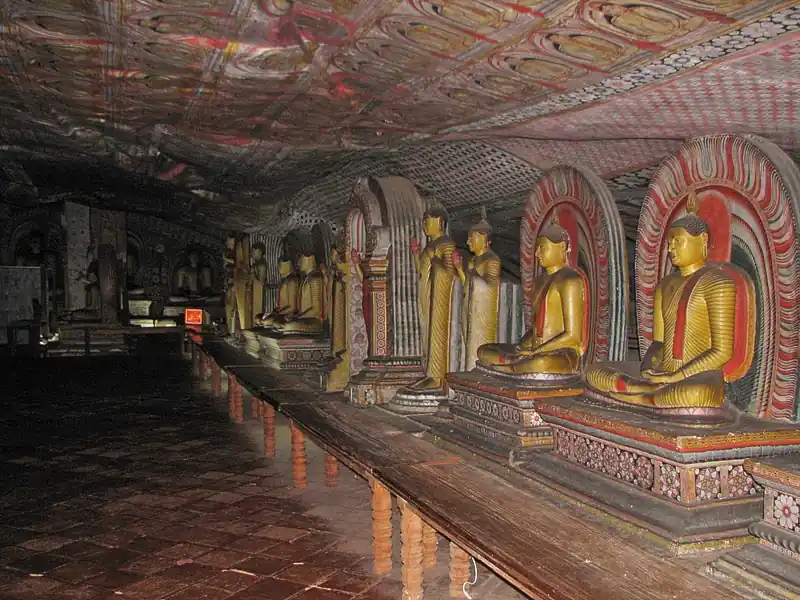Have you ever wondered about the secrets in Sri Lanka’s ancient rock temples? The Dambulla Cave Temple, a UNESCO World Heritage site, is a true marvel. It has amazed visitors for centuries. Located in the heart of the island, it has five cave sanctuaries with over 150 Buddha statues and centuries-old murals.
But what’s beneath its surface? Get ready to explore the rich history and cultural significance of the Dambulla Cave Temple. Here, the past and present blend beautifully.

History of the Dambulla Cave Temple
The Dambulla Cave Temple, also called the Golden Temple of Dambulla, is a famous and ancient place in Sri Lanka. It is not just a religious site but also an important cultural and historical treasure. Let’s learn about its amazing story!
Early People and Beginnings
People have lived near Dambulla for thousands of years. Archaeologists found signs of ancient life, like burial sites and human skeletons from 2,700 years ago. These early people were farmers and lived in this area long before Buddhism came to Sri Lanka.
A King Finds Shelter
The caves became special around the 1st century BC because of a king named Valagamba (also called Vattagamani Abhaya). He lost his throne and had to run away from enemies. For 15 years, he hid in these caves, where Buddhist monks helped and protected him.
When King Valagamba won back his throne, he decided to thank the monks by turning the caves into a beautiful temple. This marked the beginning of the Dambulla Cave Temple.
Changes Over Time
After King Valagamba, other rulers added to the temple:
5th Century AD: A small stupa (a dome-shaped structure for meditation and worship) was built inside the temple.
11th Century AD: King Nissanka Malla covered many statues with gold and added about 70 new Buddha statues.
18th Century AD: The temple got a major makeover during the Kingdom of Kandy. Colorful paintings and murals were added, showing important stories from Buddha’s life.
A World-Famous Site
In 1991, the Dambulla Cave Temple became a UNESCO World Heritage Site because of its rich history and beautiful art. It is one of the best-preserved ancient sites in Sri Lanka. Every year, thousands of visitors come to see its amazing statues, paintings, and caves.
Why It Matters
The Dambulla Cave Temple is a symbol of Sri Lanka’s history, religion, and art. It started as a safe hiding place for a king and became a grand temple over centuries. Today, it is a sacred place for Buddhists and an exciting place for visitors to learn and explore.
Architectural Features of the Dambulla Cave Temple
The Dambulla Cave Temple is built into a huge rock that rises 160 meters above the flat land around it. While there are more than 80 caves in the area, the main temple is made up of five main caves, each filled with amazing statues and paintings about Buddha and Sri Lankan history.
The Five Main Caves
Here’s what makes each cave special:
1. Cave of the Divine King (Devaraja Lena)
This is the first cave you’ll see.
It has a giant 14-meter-long statue of Buddha, carved out of the rock.
Near Buddha’s feet is his loyal disciple, Ananda, and above his head is the god Vishnu.
2. Cave of the Great Kings (Maharaja Lena)
This is the biggest cave in the temple.
It is full of Buddha statues in different poses.
The ceiling is covered with colorful paintings that show stories from Buddha’s life.
Statues of gods like Vishnu and Saman, as well as Sri Lankan kings, are also found here.
3. Cave of the Great New Temple
This cave is known for its beautiful art and statues.
A large statue of Buddha lying down represents his final moments before reaching enlightenment.
4. Cave of the New Temple
This cave has more Buddha statues and bright, colorful paintings on its walls and ceiling.
5. Cave of the Last King
This smaller cave has additional statues and artwork that reflect the temple’s long history.
Art and Architecture
The Dambulla Cave Temple is famous for its amazing art and clever design.
Murals and Paintings: The walls and ceilings are covered with pictures that tell stories about Buddha’s life and important moments in Sri Lanka’s history. The bright colors and detailed work make these murals truly special.
Statues: There are over 150 statues of Buddha, along with statues of Sri Lankan kings and gods like Vishnu and Ganesh.
Smart Design: The caves were built to keep water out, using special ledges that stop rain from dripping inside.
Fun Fact
The largest cave is about 52 meters long and 7 meters high, creating a huge and peaceful space for visitors to explore.
The Dambulla Cave Temple is not just a place of worship; it’s also a treasure of art, history, and brilliant architecture!

How to Visit the Dambulla Cave Temple
The Dambulla Cave Temple is in the middle of Sri Lanka, near the town of Dambulla. It’s a famous place to visit and is about 150 kilometers (93 miles) northeast of Colombo, Sri Lanka’s capital city. The temple sits on top of a big rock, about 160 meters (525 feet) high, and offers amazing views of the surrounding countryside.
How to Get There
You can reach the temple in different ways:
By Bus: Public buses run often from Colombo and other cities to Dambulla.
By Car: Renting a car or hiring a taxi is easy and lets you stop at other nearby places, like Sigiriya.
By Train: The nearest train station is in Habarana, about 20 kilometers from Dambulla.
Best Time to Visit
The best times to visit are early in the morning or late afternoon when it’s cooler. Try to avoid visiting during the rainy season, which usually happens between May and September.
Entry Fees
Visitors from other countries need to buy a ticket, which costs about $10–12 USD (around 1500 Sri Lankan Rupees). People from Sri Lanka pay much less.
Opening Hours
The temple is open every day from 7 AM to 7 PM, but the ticket counter closes at 5 PM. It’s a good idea to go early so you have plenty of time to explore.
Since this is a sacred site, wear clothes that cover your shoulders and knees. You’ll also need to take off your shoes before going inside the caves.
Helpful Tips
Climbing the Stairs: The temple is at the top of a hill, and there are many stairs, so wear comfortable shoes.
Bring Water: It can get hot, so carry water to stay hydrated.
Enjoy the View: From the top, you can see green forests, hills, and even Sigiriya Rock Fortress in the distance.
Other Places to See Nearby
If you’re visiting Dambulla, here are some other places to check out:
Sigiriya Rock Fortress: An ancient palace built on top of a giant rock.
Minneriya National Park: A great place to see elephants and other wildlife.
Kandalama Lake: A peaceful spot for relaxing and birdwatching.
Where to Stay
You can find places to stay in Dambulla for all budgets. Here are a few:
Heritance Kandalama: A fancy hotel with amazing views of nature.
Dambulla Cave Resort: A comfortable hotel close to the temple.
Sundaras Resort & Spa: A nice place to relax with modern facilities.
♣♣You May Also Like:⇓
- Remarkable Burmese Buddhist Temple in Singapore
- Great Sule Pagoda: the old Treasure of Yangon
- Unique Devni Mori: A old and Lost Buddhist Heritage
- Beautiful Mahabodhi Temple: Heart of the Spiritual Glory
- Ranakpur Jain Temple, Rajasthan: A Marvel in Marble
Conclusion
Visiting the Dambulla Cave Temple is like stepping into a beautiful storybook of Sri Lanka’s history and culture. The ancient statues and paintings are full of meaning, and the view from the top is unforgettable.
This special place isn’t just a temple—it’s a window into Sri Lanka’s past and a chance to experience its beauty and spirituality. Add it to your travel list, and get ready for an adventure you’ll always remember!
FAQs:
1. What is the Dambulla Cave Temple?
The Dambulla Cave Temple is a UNESCO World Heritage Site in Sri Lanka known for its ancient rock caves filled with statues and murals depicting Buddha’s life.
2. Where is the Dambulla Cave Temple located?
It is located in the central part of Sri Lanka, about 150 kilometers (93 miles) northeast of Colombo.
3. How many caves are there in the Dambulla Cave Temple complex?
There are over 80 caves in the area, but the main temple consists of five primary caves.
4. Is there an entry fee for the temple?
Yes, foreign visitors need to pay around $10–12 USD for entry, while Sri Lankan citizens have a lower fee.
5. How do I get to the Dambulla Cave Temple?
You can reach Dambulla by bus, car, or train. It’s easily accessible from nearby attractions like Sigiriya.
6. What are the opening hours of the temple?
The temple is open from 7 AM to 7 PM daily; however, ticket sales close at 5 PM.
7. Are there any nearby attractions to visit?
Yes! Nearby attractions include Sigiriya Rock Fortress, Minneriya National Park, and Kandalama Lake.
8. Is it safe to climb to the temple?
Yes, but visitors should be cautious as there are many stairs leading up to the caves.
9. Are guided tours available at the temple?
Yes, guided tours are often available and can enhance your understanding of the temple‘s history and significance.
10. Can I find accommodation near Dambulla?
Yes, there are various accommodation options ranging from budget guesthouses to luxury hotels near Dambulla.
11. What makes Dambulla Cave Temple a must-visit site in Sri Lanka?
Its rich history, stunning art and architecture, spiritual significance, and breathtaking views make it a unique cultural experience that shouldn’t be missed when visiting Sri Lanka.